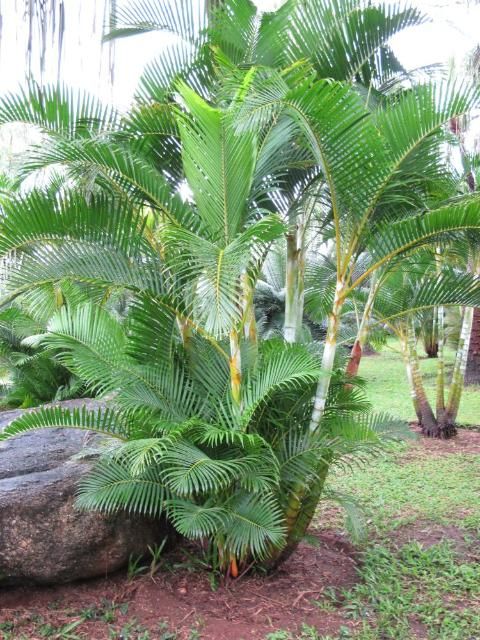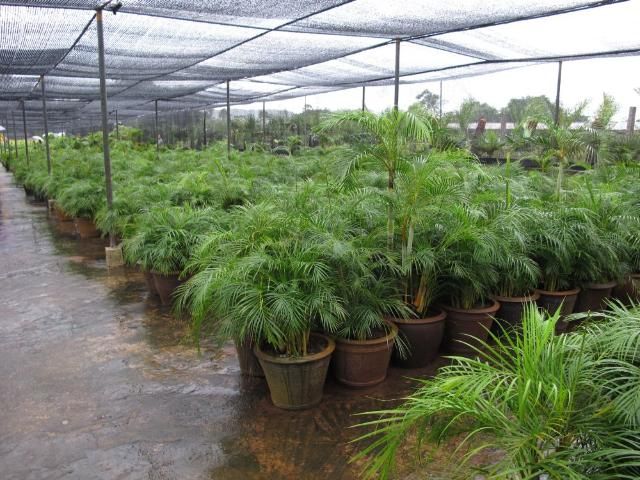Family
Arecaceae, palm family.
Genus
The history behind the genus name Dypsis is unknown.
Species
The species name lutescens is the Latin term for "growing yellow," and it alludes to this palm's yellow petioles or stems.
Common Names
Areca Palm, Golden Cane Palm, Yellow Bamboo Palm
Years of widespread cultivation have earned this palm numerous common names. While areca means "tender palm," it is unclear to what this name refers. Most of its other common names likely came from physiological characteristics, such as the yellow color of its plant parts, which results from high sun exposure or nutrient deficiencies, and the cane- or bamboo-like appearance of its stems.
Description
Areca palm is endemic to eastern Madagascar, where it is endangered due to the loss of its natural habitat in open areas of hydric forests and along riverbanks. In Florida and throughout the United States, areca palm is a common landscape plant that survives best where the average annual low temperature ranges from 35 to 40°F. This palm typically grows to between 20 to 35 feet tall and has a crown spread of 10 to 20 feet. It can tolerate full sun to partial shade and grows best in well-drained soils where it has access to plenty of water. The yellowish-green to dark green leaves or fronds are pinnately compound, grow between 6 to 8 feet in length, and are ovoid in shape. Leaflets are 2 feet long, lance shaped, and create a distinct "V" shape on the leaf because they grow in opposite directions from one another along the center of the orange to light green rachis. The trunk of this palm is multi-stemmed, and each stem is 2 to 3 inches in diameter. Tightly packed rings or leaf scars extend the length of the trunk, and they range in color from orange and yellow to dark green, with lighter colors resulting from greater sun exposure. Branching, yellow flower stalks emerge from below the leaves and droop downward. Each fruit is approximately 1 inch long and shaped like an egg, and the fruit turns from yellow to dark purple or black as it matures.

Credit: Scott Zona, CC BY 2.0
Applications
Horticultural
This palm is grown indoors or outdoors. When grown outdoors, it can accent the landscape or make a great natural fence. In general, it should be planted during the summer rainy season to allow its roots to fully establish and its fronds to branch out. When used for accent, areca palms can be planted in clusters and the lower fronds pruned to show the attractive stems, as well as to prevent fungus or insect infestations. These palms may also be planted in clusters that are spaced 10 feet apart. Eventually, the clusters will create a screen as the palms grow and their fronds spread out horizontally. Some horticultural experts recommend fertilizing the palm regularly to keep it green; however, yellowing is a natural feature of this plant and can be regulated somewhat with shading.

Credit: Scott Zona, CC BY 2.0
References
Coombes, A. 1994. Dictionary of plant names: Botanical names and their common name equivalents. Portland, OR: Timber Press.
Floridata.com. 2008. Dypsis lutescens, Retrieved from http://www.floridata.com/ref/D/dyps_lut.cfm
MacCubbin, T. 2005. Month-by-month gardening in Florida: What to do each month to have a beautiful garden all year (Revised ed.). Franklin, TN: Cool Springs Press.
Riffle, R. L. and P. Craft. 2003. An encyclopedia of cultivated palms. Portland, OR: Timber Press, Inc.
Rushing, F. 2005. Tough plants for Florida gardens: Low care, no care, tried and true winners. Franklin, TN: Cool Springs Press.
MacCubbin, T. and G. B. Tasker. 2002. Florida gardener's guide (Revised ed.). Nashville, TN: Cool Springs Press.